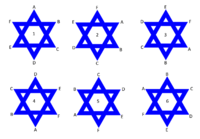Hi, I got some quiz questions about symmetry which I really have not studied. With common sense, I believe I've answered the 2 first questions correctly but I'm stuck on what is meant with the third question:
Consider a Star of David (6-pointed star)
Q1: Number of rotational symmetry including the original?
A1: 6
Q2: Number of mirror symmetries, not including the original?
A2: 1 (the shape will be the same, but the top point will be the bottom point in the mirror I guess so I think 1 is the answer and not 0)
Q3: Number of different elements in the group of symmetries a Star of David?
A3:
Consider a Star of David (6-pointed star)
Q1: Number of rotational symmetry including the original?
A1: 6
Q2: Number of mirror symmetries, not including the original?
A2: 1 (the shape will be the same, but the top point will be the bottom point in the mirror I guess so I think 1 is the answer and not 0)
Q3: Number of different elements in the group of symmetries a Star of David?
A3:

